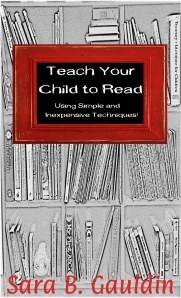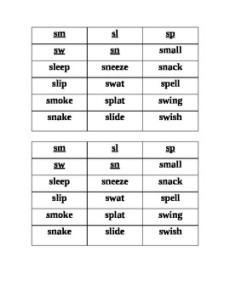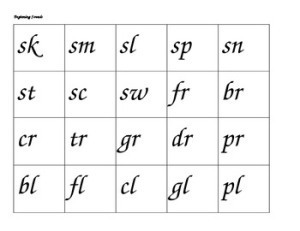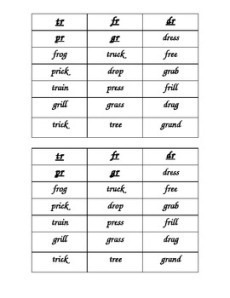Teach Your Child to Read: What about all the longer words with short vowel sounds?

As your child is progressing with the reading acquisition process, they should now be being read to, practicing directionality word tracking and sight words and learning about the alphabet based phonics sounds. If all of these elements are in the works, and your child has become comfortable with using letters to create words, then it is time to take phonics sounds to the next level by incorporating basic blends and digraphs.
What are blends?
Blends are the result of two or three letter combinations that work together to make a sound. Blends keep the sound characteristics of the letters in them. Most early readers will focus on a few subgroups of blends that are used with frequency.
L blends include bl as in black, fl as in flop, cl as in clam, gl as in glad and pl as in plant.
S blends include sk as in skip, sm as in small, sl as in slip, sp as in spin sn as in snack, st as in stand, sc as in scar, and sw as in swat.
R blends include fr as in frog, br as in brown, cr as in cram, tr as in track, gr as in grand, dr as in drat, and pr as in prick.
Try This!
Use notecards to introduce the combination of two consonant sounds. Write one letter on a card. Review the consonant’s sound with your child. Add a second letter on a separate card. Review that sound. Place the cards side by side and help your child to sound out the consonant blend. It is best to begin with one family of blends. This way only one consonant will need to be changed as you introduce the sound combinations with the cards. For instance, if I was introducing r blends I would make an r card, then a card with f, b, c, t, g, d, and p. I would begin by modeling the fr sound. I would then take away the f, and add a b to model br. In the same manner as the push and say it letters, it is better to call the letters by their sound rather than their name.
Word sorts are a great tool to reinforce beginning blends. Before attempting to sort, talk to your child about the sounds they will look for. Guide them to sound out the letters. Help your child to read each word on the sort before ever cutting the letters apart. The child should place the underlined headers at the top of the column. The child should then identify words with like sounds before placing the words under the proper heading. Once the child has completed the sort with adult help, they should read the words to an adult down the column.
There are many other activities that can be used to extend the sort activity and make it more effective. After a few practices you can try a speed sort; have the child sort while you time them, then have them attempt to beat their time. Writing the sort in columns under the correct header is a valid practice. A blind sort is another option; Display only the headers. Call out the words from the sort or other sorts that have the same sound pattern while the child identifies which heading the word belongs with.
S Blends Sort
http://www.teacherspayteachers.com/Product/Word-Sort-s-blends-371178

R Blends Sort
http://www.teacherspayteachers.com/Product/Word-Sort-r-blends-371149
Writing sorts are a great tool for reinforcing letter blends. Begin by dividing a sheet of paper into two sections. Label each side with a specific blend sound. Chose two blend sounds to compare. Call out words that begin with these sounds so you child can attempt to write the words in the correct column. Be aware of vowel sounds when you choose words. At this stage in phonics instruction is it best to practice blends with short vowel sounds (the sounds we learn with the letters when we learn the alphabet). After your child writes the word in the column talk with them about why it belongs there or why it does not. If the child misplaces the word have them sound the word out and move it to its correct place. Go over the correct spelling of the word once it is placed. Have your child make any needed corrections.

Blend Practice Cards
http://www.teacherspayteachers.com/Product/Blends-Cards-for-sorting-and-recognition-games-371121
These blends are great for “find it” games. Try laying the blends out for the child to see, then calling out a word that begins with one of the blend sounds. Guide your child to listen for the sounds at the beginning of the word and to stretch out the sounds they hear so they can determine the letter sounds that made them. The child should hold up or point to the correct blend. This activity can be limited by only giving the child specific blends to compare to one another. The same type of activity can be done by labeling note cards or slips of paper.
As your child grows with reading skills application is the key to mastery. Visit your local library. Ask your librarian to help you find books for early readers that contain letter feature you are practicing with your child. Echo read (have your child read each line after you as you read) then chorally read (read together) the book. Page by page have your child find the featured blend. It is practical to have your child write the words they find to reinforce the concept.
What are digraphs?
Digraphs are groups of two or three letters that join together to make their own separate sound instead of the individual letter sounds. Unlike the blends, your child will need to memorize the sound that each digraph makes as though it is a new letter of the alphabet. They will not be able to sound out a digraph in a way that will make a word correctly. For early readers there are four digraphs that are crucial.
ch as in chain or cheese, wh as in whale or where, th as in think or this, and sh as in shut or share
Try This!
Digraphs cannot be sounded out in the same way blends can. Because they make their own sound in the same manner as a letter of the alphabet they need to be memorized.
Make digraph flash cards and practice the sounds in the same manner as the letters of the alphabet. Begin with digraphs listed above. At an early stage of literacy these are appropriate. Help your child to practice the sounds until they are able to recognize them automatically.
Once your child is correcting the digraphs the majority of the time you can introduce the same activities that were used with the blends.






